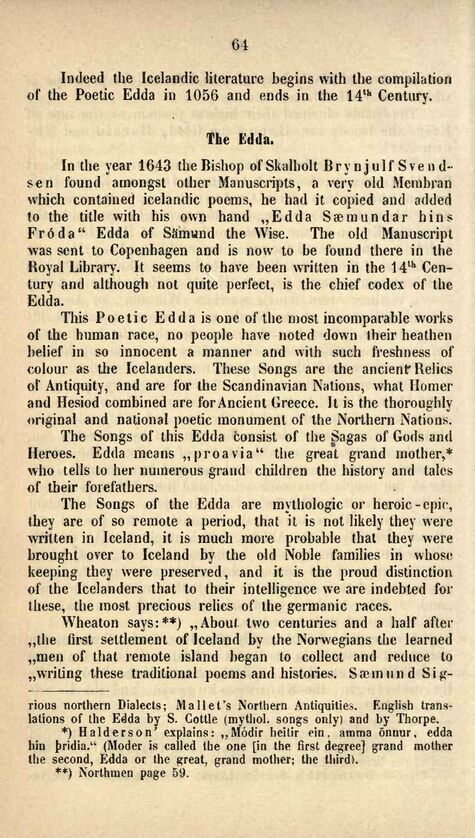
Full resolution (JPEG) - On this page / på denna sida - The Old Norsk Poetry and the Sagas

<< prev. page << föreg. sida << >> nästa sida >> next page >>
Below is the raw OCR text
from the above scanned image.
Do you see an error? Proofread the page now!
Här nedan syns maskintolkade texten från faksimilbilden ovan.
Ser du något fel? Korrekturläs sidan nu!
This page has been proofread at least once.
(diff)
(history)
Denna sida har korrekturlästs minst en gång.
(skillnad)
(historik)
Indeed the Icelandic literature begins with the compilation
of the Poetic Edda in 1056 and ends in the 14th Century.
The Edda.
In the year 1643 the Bishop of Skalholt Brynjulf
Svendsen found amongst other Manuscripts, a very old Membran
which contained icelandic poems, he had it copied and added
to the title with his own hand „Edda Sæmundar hins
Fróda“ Edda of Sämund the Wise. The old Manuscript
was sent to Copenhagen and is now to be found there in the
Royal Library. It seems to have been written in the 14th
Century and although not quite perfect, is the chief codex of the
Edda.
This Poetic Edda is one of the most incomparable works
of the human race, no people have noted down their heathen
belief in so innocent a manner and with such freshness of
colour as the Icelanders. These Songs are the ancient Relics
of Antiquity, and are for the Scandinavian Nations, what Homer
and Hesiod combined are for Ancient Greece. It is the thoroughly
original and national poetic monument of the Northern Nations.
The Songs of this Edda consist of the Sagas of Gods and
Heroes. Edda means „proavia“ the great grand mother,[1]
who tells to her numerous grand children the history and tales
of their forefathers.
The Songs of the Edda are mythologic or heroic-epic,
they are of so remote a period, that it is not likely they were
written in Iceland, it is much more probable that they were
brought over to Iceland by the old Noble families in whose
keeping they were preserved, and it is the proud distinction
of the Icelanders that to their intelligence we are indebted for
these, the most precious relics of the germanic races.
Wheaton says:[2] „About two centuries and a half after
the first settlement of Iceland by the Norwegians the learned
men of that remote island began to collect and reduce to
writing these traditional poems and histories. Sæmund
<< prev. page << föreg. sida << >> nästa sida >> next page >>